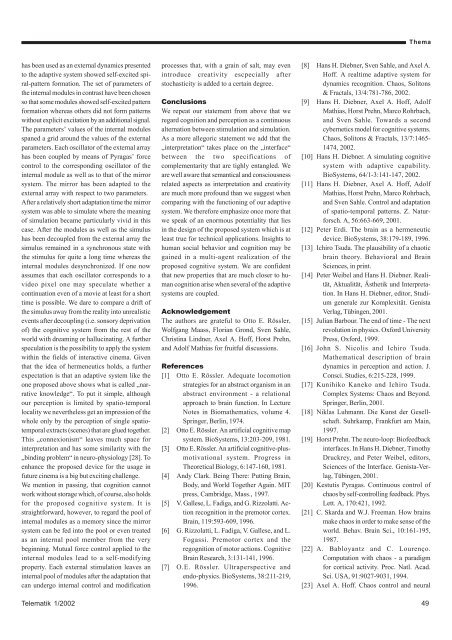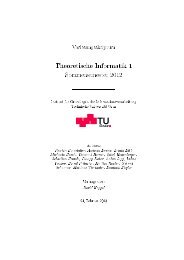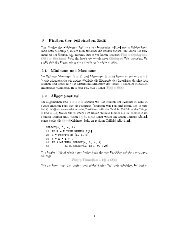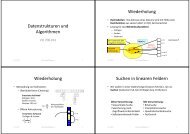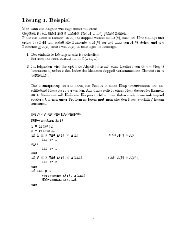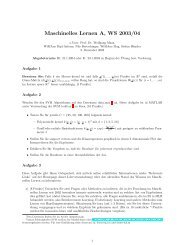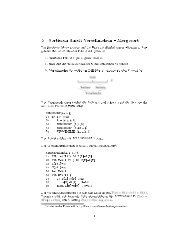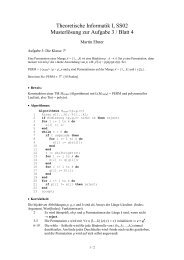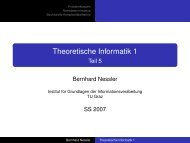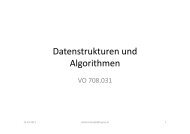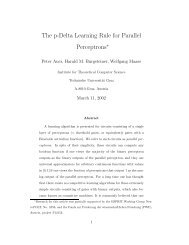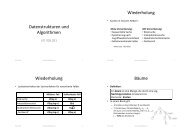Telematik 2/02 - Institut für Grundlagen der Informationsverarbeitung ...
Telematik 2/02 - Institut für Grundlagen der Informationsverarbeitung ...
Telematik 2/02 - Institut für Grundlagen der Informationsverarbeitung ...
You also want an ePaper? Increase the reach of your titles
YUMPU automatically turns print PDFs into web optimized ePapers that Google loves.
has been used as an external dynamics presented<br />
to the adaptive system showed self-excited spiral-pattern<br />
formation. The set of parameters of<br />
the internal modules in contrast have been chosen<br />
so that some modules showed self-excited pattern<br />
formation whereas others did not form patterns<br />
without explicit excitation by an additional signal.<br />
The parameters’ values of the internal modules<br />
spaned a grid around the values of the external<br />
parameters. Each oscillator of the external array<br />
has been coupled by means of Pyragas’ force<br />
control to the corresponding oscillator of the<br />
internal module as well as to that of the mirror<br />
system. The mirror has been adapted to the<br />
external array with respect to two parameters.<br />
After a relatively short adaptation time the mirror<br />
system was able to simulate where the meaning<br />
of simulation became particularly vivid in this<br />
case. After the modules as well as the simulus<br />
has been decoupled from the external array the<br />
simulus remained in a synchronous state with<br />
the stimulus for quite a long time whereas the<br />
internal modules desynchronized. If one now<br />
assumes that each oscillator corresponds to a<br />
video pixel one may speculate whether a<br />
continuation even of a movie at least for a short<br />
time is possible. We dare to compare a drift of<br />
the simulus away from the reality into unrealistic<br />
events after decoupling (i.e. sonsory deprivation<br />
of) the cognitive system from the rest of the<br />
world with dreaming or hallucinating. A further<br />
speculation is the possibility to apply the system<br />
within the fields of interactive cinema. Given<br />
that the idea of hermeneutics holds, a further<br />
expectation is that an adaptive system like the<br />
one proposed above shows what is called „narrative<br />
knowledge“. To put it simple, although<br />
our perception is limited by spatio-temporal<br />
locality we nevertheless get an impression of the<br />
whole only by the perception of single spatiotemporal<br />
extracts (scenes) that are glued together.<br />
This „connexionism“ leaves much space for<br />
interpretation and has some similarity with the<br />
„binding problem“ in neuro-physiology [28]. To<br />
enhance the proposed device for the usage in<br />
future cinema is a big but exciting challenge.<br />
We mention in passing, that cognition cannot<br />
work without storage which, of course, also holds<br />
for the proposed cognitive system. It is<br />
straightforward, however, to regard the pool of<br />
internal modules as a memory since the mirror<br />
system can be fed into the pool or even treated<br />
as an internal pool member from the very<br />
beginning. Mutual force control applied to the<br />
internal modules lead to a self-modifying<br />
property. Each external stimulation leaves an<br />
internal pool of modules after the adaptation that<br />
can un<strong>der</strong>go internal control and modification<br />
<strong>Telematik</strong> 1/20<strong>02</strong><br />
processes that, with a grain of salt, may even<br />
introduce creativity escpecially after<br />
stochasticity is added to a certain degree.<br />
Conclusions<br />
We repeat our statement from above that we<br />
regard cognition and perception as a continuous<br />
alternation between stimulation and simulation.<br />
As a more allegoric statement we add that the<br />
„interpretation“ takes place on the „interface“<br />
between the two specifications of<br />
complementarity that are tighly entangled. We<br />
are well aware that semantical and consciousness<br />
related aspects as interpretation and creativity<br />
are much more profound than we suggest when<br />
comparing with the functioning of our adaptive<br />
system. We therefore emphasize once more that<br />
we speak of an enormous potentiality that lies<br />
in the design of the proposed system which is at<br />
least true for technical applications. Insights to<br />
human social behavior and cognition may be<br />
gained in a multi-agent realization of the<br />
proposed cognitive system. We are confident<br />
that new properties that are much closer to human<br />
cognition arise when several of the adaptive<br />
systems are coupled.<br />
Acknowledgement<br />
The authors are grateful to Otto E. Rössler,<br />
Wolfgang Maass, Florian Grond, Sven Sahle,<br />
Christina Lindner, Axel A. Hoff, Horst Prehn,<br />
and Adolf Mathias for fruitful discussions.<br />
References<br />
[1] Otto E. Rössler. Adequate locomotion<br />
strategies for an abstract organism in an<br />
abstract environment - a relational<br />
approach to brain function. In Lecture<br />
Notes in Biomathematics, volume 4.<br />
Springer, Berlin, 1974.<br />
[2] Otto E. Rössler. An artificial cognitive map<br />
system. BioSystems, 13:203-209, 1981.<br />
[3] Otto E. Rössler. An artificial cognitive-plusmotivational<br />
system. Progress in<br />
Theoretical Biology, 6:147-160, 1981.<br />
[4] Andy Clark. Being There: Putting Brain,<br />
Body, and World Together Again. MIT<br />
press, Cambridge, Mass., 1997.<br />
[5] V. Gallese, L. Fadiga, and G. Rizzolatti. Action<br />
recognition in the premotor cortex.<br />
Brain, 119:593-609, 1996.<br />
[6] G. Rizzolatti, L. Fadiga, V. Gallese, and L.<br />
Fogassi. Premotor cortex and the<br />
regognition of motor actions. Cognitive<br />
Brain Research, 3:131-141, 1996.<br />
[7] O.E. Rössler. Ultraperspective and<br />
endo-physics. BioSystems, 38:211-219,<br />
1996.<br />
Thema<br />
[8] Hans H. Diebner, Sven Sahle, and Axel A.<br />
Hoff. A realtime adaptive system for<br />
dynamics recognition. Chaos, Solitons<br />
& Fractals, 13/4:781-786, 20<strong>02</strong>.<br />
[9] Hans H. Diebner, Axel A. Hoff, Adolf<br />
Mathias, Horst Prehn, Marco Rohrbach,<br />
and Sven Sahle. Towards a second<br />
cybernetics model for cognitive systems.<br />
Chaos, Solitons & Fractals, 13/7:1465-<br />
1474, 20<strong>02</strong>.<br />
[10] Hans H. Diebner. A simulating cognitive<br />
system with adaptive capability.<br />
BioSystems, 64/1-3:141-147, 20<strong>02</strong>.<br />
[11] Hans H. Diebner, Axel A. Hoff, Adolf<br />
Mathias, Horst Prehn, Marco Rohrbach,<br />
and Sven Sahle. Control and adaptation<br />
of spatio-temporal patterns. Z. Naturforsch.<br />
A, 56:663-669, 2001.<br />
[12] Peter Erdi. The brain as a hermeneutic<br />
device. BioSystems, 38:179-189, 1996.<br />
[13] Ichiro Tsuda. The plausibility of a chaotic<br />
brain theory. Behavioral and Brain<br />
Sciences, in print.<br />
[14] Peter Weibel and Hans H. Diebner. Realität,<br />
Aktualität, Ästhetik und Interpretation.<br />
In Hans H. Diebner, editor, Studium<br />
generale zur Komplexität. Genista<br />
Verlag, Tübingen, 2001.<br />
[15] Julian Barbour. The end of time - The next<br />
revolution in physics. Oxford University<br />
Press, Oxford, 1999.<br />
[16] John S. Nicolis and Ichiro Tsuda.<br />
Mathematical description of brain<br />
dynamics in perception and action. J.<br />
Consci. Studies, 6:215-228, 1999.<br />
[17] Kunihiko Kaneko and Ichiro Tsuda.<br />
Complex Systems: Chaos and Beyond.<br />
Springer, Berlin, 2001.<br />
[18] Niklas Luhmann. Die Kunst <strong>der</strong> Gesellschaft.<br />
Suhrkamp, Frankfurt am Main,<br />
1997.<br />
[19] Horst Prehn. The neuro-loop: Biofeedback<br />
interfaces. In Hans H. Diebner, Timothy<br />
Druckrey, and Peter Weibel, editors,<br />
Sciences of the Interface. Genista-Verlag,<br />
Tübingen, 2001.<br />
[20] Kestutis Pyragas. Continuous control of<br />
chaos by self-controlling feedback. Phys.<br />
Lett. A, 170:421, 1992.<br />
[21] C. Skarda and W.J. Freeman. How brains<br />
make chaos in or<strong>der</strong> to make sense of the<br />
world. Behav. Brain Sci., 10:161-195,<br />
1987.<br />
[22] A. Babloyantz and C. Lourenço.<br />
Computation with chaos - a paradigm<br />
for cortical activity. Proc. Natl. Acad.<br />
Sci. USA, 91:9<strong>02</strong>7-9031, 1994.<br />
[23] Axel A. Hoff. Chaos control and neural<br />
49


